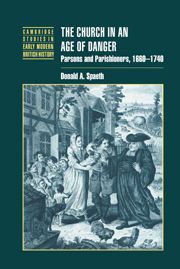Book contents
- Frontmatter
- Contents
- List of tables
- Acknowledgements
- List of abbreviations
- 1 Introduction
- 2 Clerical profiles
- 3 Arenas for conflict
- 4 The management of disputes
- 5 Pastoral care
- 6 Tithes and religious conflict
- 7 The nonconformist threat
- 8 Popular observance
- 9 Matters of life and death
- 10 Singing and religious revival
- 11 Conclusion
- Selected bibliography
- Index
- Cambridge Studies in Early Modern British History
7 - The nonconformist threat
Published online by Cambridge University Press: 28 July 2009
- Frontmatter
- Contents
- List of tables
- Acknowledgements
- List of abbreviations
- 1 Introduction
- 2 Clerical profiles
- 3 Arenas for conflict
- 4 The management of disputes
- 5 Pastoral care
- 6 Tithes and religious conflict
- 7 The nonconformist threat
- 8 Popular observance
- 9 Matters of life and death
- 10 Singing and religious revival
- 11 Conclusion
- Selected bibliography
- Index
- Cambridge Studies in Early Modern British History
Summary
Throughout the century after the Restoration nonconformity appeared to many clergymen to represent the greatest threat to the Church of England. Separatists were a constant reminder of the failure of the Restoration settlement of religion. After 1689, the issue of the treatment of dissent remained important as an ideological fault line dividing the political elite between High Church Tories who wished to restore the monopoly of the Church establishment and anticlerical Whigs who decried the intolerance of churchmen. Nonconformity was defined by the refusal to accept the patterns of worship laid down by the liturgy of the Church of England. The 1662 Prayer Book confirmed such contentious elements of worship as saying set prayers, wearing priestly vestments, making the ritual sign of the cross at baptism, and showing reverence at the name of Jesus, to which the puritans had objected before the Civil Wars. The Act of Uniformity made the Prayer Book central to the definition of Anglicanism, and the Church sought to stamp out separatism by detecting and disciplining anyone who failed to attend church or to observe church ceremonies. The Test and Corporation Acts in turn elevated the importance of communion, particularly after the passage of the Act of Toleration. Yet this insistence upon uniformity had negative effects, for it contributed to the unpopularity of the Church, both locally and nationally.
- Type
- Chapter
- Information
- The Church in an Age of DangerParsons and Parishioners, 1660–1740, pp. 155 - 172Publisher: Cambridge University PressPrint publication year: 2000



